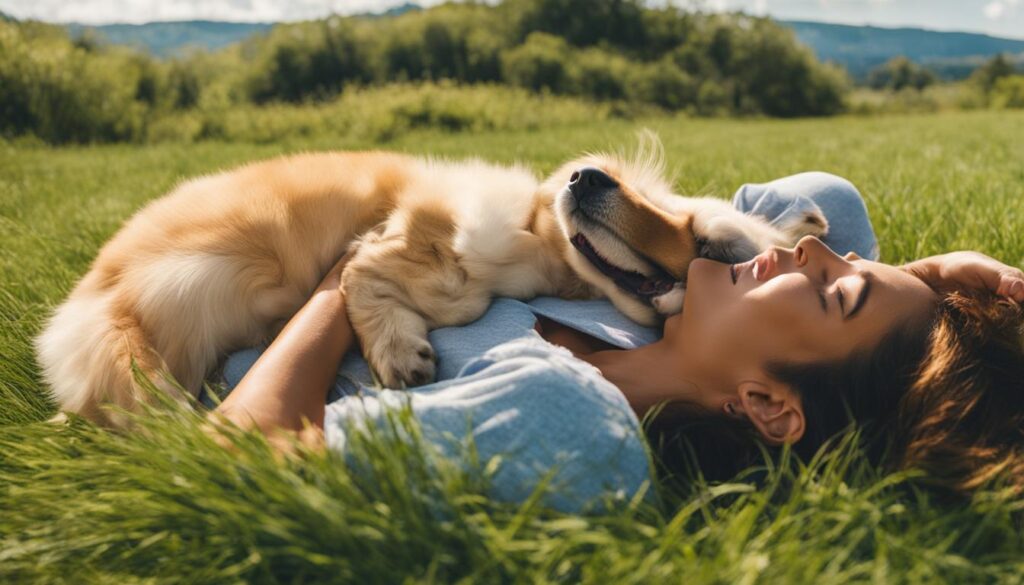Why Do Dogs Love Belly Rubs? Uncover the Joy!
Dogs have a natural affinity for belly rubs, and it’s a behavior that stems from their desire for social connection. While there is no scientific research specifically on why dogs love belly rubs, experts believe that it is a way for dogs to connect with their owners and receive physical affection. The fur on the belly is usually less dense and softer, so the sensation of being touched is more pronounced. Some dogs even prefer touch to other types of rewards like treats or toys. It’s a bonding experience that can strengthen the relationship between dogs and their owners.
Key Takeaways:
- Dogs love belly rubs as a way to connect with their owners and receive physical affection.
- The fur on the belly is usually softer and less dense, which enhances the sensation of being touched.
- Belly rubs can be a bonding experience that strengthens the relationship between dogs and their owners.
- Some dogs prefer touch over other rewards like treats or toys.
- Not all dogs enjoy belly rubs, so it’s important to understand their body language and preferences.
The Myth of Universal Belly Rub Love
Contrary to popular belief, not all dogs love belly rubs. While many do enjoy this form of physical affection, some dogs may see attempts to rub their bellies as aggression, especially more dominant breeds or guard dogs. It’s essential to understand your dog’s body language cues to determine if they are inviting a belly rub or communicating something else.
Rolling onto their back can also be a tactical posture during play or a signal of submission when a dog is afraid or threatened. Dogs have various reasons for rolling onto their backs, so it’s crucial to interpret their body language holistically.
| Dogs and Belly Rubs: Fact vs. Myth | Body Language Signs |
|---|---|
| Fact: Not all dogs enjoy belly rubs | Sign: Avoidance, tense body posture |
| Myth: All dogs love belly rubs | Sign: Relaxation, invitation for interaction |
| Fact: Some dogs may interpret belly rubs as aggression | Sign: Growling, snapping, or defensive body language |
| Myth: Dogs always roll onto their backs to signal submission | Sign: Playful body language, wagging tail |
To ensure a positive and respectful interaction with your dog, pay attention to their body language and respect their boundaries. As the next section will discuss, there are many other ways to bond and show affection to your furry friend.
The Benefits and Joy of Belly Rubs
Belly rubs offer more than just pleasure for dogs. They can also provide several benefits.
When dogs receive belly rubs, it releases endorphins, the “feel-good” hormones, which can improve their mood and reduce stress. Dogs who enjoy belly rubs may show signs of relaxation, close their eyes, and even melt into the touch. This soothing interaction can create a calm and contented state for your furry friend.
But it’s not just about the physical sensation. Belly rubs promote bonding between dogs and their owners. It’s a form of affectionate touch that strengthens the connection and trust between you and your canine companion. By dedicating time to give your dog belly rubs, you are nurturing the emotional bond and deepening your relationship.
Furthermore, belly rubs can have additional health benefits for your dog. The massage-like motion stimulates blood flow and improves circulation, which can enhance their overall well-being. It also aids in digestion, helping to ease any discomfort or irregularities that your dog may experience.
Here’s a table summarizing the benefits of belly rubs for dogs:
| Benefits |
|---|
| Release of endorphins |
| Promotes bonding |
| Improves circulation |
| Aids digestion |
Remember, every dog is unique, and not all dogs enjoy belly rubs. It’s important to respect your dog’s boundaries and preferences. If your dog shows signs of discomfort or avoidance during belly rubs, try alternative forms of affection that they enjoy.
Continue reading to learn more about understanding your dog’s preferences and giving the perfect belly rub.
Understanding Canine Preferences
When it comes to physical affection, dogs have their own unique preferences, including their response to belly rubs. While some dogs absolutely adore belly rubs, others may prefer different types of petting, such as head scratches or back rubs. Understanding what your dog enjoys requires careful observation of their body language and reactions.
If your dog willingly rolls over onto their back and shows signs of relaxation, engagement, or even enjoyment, it’s likely they are inviting a belly rub. These signs may include wagging their tail, displaying relaxed facial expressions, and may even nudge you for more attention. Their body language serves as a clear indication that they are comfortable and receptive to a belly rub.
However, it’s crucial to be mindful of signs of discomfort or avoidance. If your dog avoids eye contact, tenses their body, or tries to move away from your touch, they may not enjoy belly rubs. Respect their boundaries and look for alternative ways to express affection and provide physical touch.
Reading Your Dog’s Body Language
To understand your dog’s preferences, pay close attention to their body language cues during interactions. Here are some key indicators to consider:
- Relaxed Posture: A dog that is comfortable and enjoying the interaction will have a loose and relaxed body posture. They may lie on their back, legs in the air, or may be lying on their side with their belly exposed.
- Soft Facial Expressions: Look for relaxed facial muscles, open and squint-free eyes, and a mouth that appears loose and content.
- Tail Wagging: A gentle wagging tail, not too slow or too stiff, can be a sign of enjoyment and pleasure.
Remember, every dog is unique, and what may be enjoyable for one dog might not necessarily apply to another. Respect your dog’s individual preferences and adjust your interaction style accordingly.
By understanding your dog’s preferences and respecting their boundaries, you can establish a stronger bond and deepen the trust between you and your furry companion. The key is to observe and listen to what your dog is telling you through their body language and respond accordingly.
Giving the Perfect Belly Rub
To provide your dog with the perfect belly rub, it is crucial to understand their preferences and ensure their comfort. Here are some techniques and tips to help you give a satisfying belly rub:
1. Find a Comfortable Spot
Start by finding a quiet and comfortable spot where both you and your dog can relax. This could be on a cozy rug, your dog’s favorite bed, or even outside in the park.
2. Use a Gentle Touch
When giving a belly rub, use a gentle touch to avoid overwhelming your dog. Start by softly stroking the upper region of their chest, moving your hand in gentle circular motions. Avoid touching their head, as some dogs may find it uncomfortable or intrusive.
3. Pay Attention to Body Language
Pay close attention to your dog’s body language during the belly rub. Watch for signs of relaxation, such as a loose body posture, soft eyes, and a wagging tail. If your dog appears anxious, tense, or tries to move away, it’s crucial to respect their boundaries and stop the belly rub.
4. Adjust the Pressure and Technique
Every dog is unique, so it’s essential to adjust the pressure and technique based on their individual preferences. Some dogs may enjoy a firmer touch, while others prefer a lighter, more soothing rub. Observe your dog’s reactions and adapt accordingly.
5. Respect Your Dog’s Boundaries
If your dog shows any signs of discomfort or stress during the belly rub, it’s crucial to respect their boundaries. Not all dogs enjoy belly rubs, and forcing it upon them may lead to a negative association. Instead, explore alternative ways to show your dog affection, such as gentle petting on their back or offering a favorite treat.
Remember, giving a belly rub should be a positive and enjoyable experience for both you and your dog. By understanding their preferences, respecting their boundaries, and providing them with the right amount of physical affection, you can create a bonding moment that strengthens your relationship.

| Benefits of Giving a Belly Rub | How to Perform a Belly Rub |
|---|---|
|
|
Conclusion
Dogs love belly rubs for a multitude of reasons. The pleasurable sensation they experience when their bellies are rubbed is undeniable. Not only does it feel good for them, but it also strengthens the bond between dogs and their owners. Understanding your dog’s body language and preferences is crucial in providing them with the affection and physical touch they desire.
It’s important to keep in mind that not all dogs enjoy belly rubs. Some may have different preferences when it comes to receiving physical affection. It is essential to respect their boundaries and find alternative ways to show them love and affection.
Belly rubs are just one aspect of the complex and wonderful world of a dog’s love language. The joy and connection they bring are undeniable. So, whether your furry friend loves belly rubs or not, remember to listen to their cues and provide the affection and physical touch that they truly enjoy.
FAQ
Why do dogs love belly rubs?
Dogs love belly rubs because it provides them with a pleasurable sensation and helps strengthen their bond with their owners. While there is no scientific research specifically on this topic, experts believe that belly rubs fulfill a dog’s desire for social connection and physical affection.
Do all dogs love belly rubs?
Contrary to popular belief, not all dogs love belly rubs. Some dogs may perceive attempts to rub their bellies as aggression, especially dominant breeds or guard dogs. It’s crucial to understand your dog’s body language cues to determine if they enjoy belly rubs or if they are communicating something else.
What are the benefits of belly rubs for dogs?
Belly rubs offer more than just pleasure for dogs. They can release endorphins, improve their mood, and reduce stress. Belly rubs also promote bonding between dogs and their owners and can help with circulation and digestion. However, it’s important to respect a dog’s boundaries and preferences, as not all dogs enjoy belly rubs.
Do all dogs prefer belly rubs as a form of physical affection?
Each dog has its own unique preferences when it comes to physical affection. While some dogs may enjoy belly rubs, others may prefer head scratches or back rubs. It’s essential to read your dog’s body language and observe their reactions to determine what type of physical affection they enjoy.
How can I give my dog the perfect belly rub?
Giving a great belly rub requires understanding your dog’s preferences and ensuring they are comfortable. Start by finding a comfortable spot for both you and your dog, focus on the upper region of their chest, and avoid their head. Pay attention to their body language and adjust the pressure or technique accordingly. If your dog seems relaxed and engaged, you can continue. If they show signs of anxiety or discomfort, it’s best to stop and find alternative ways to show them affection.
Why is it important to respect a dog’s boundaries?
It’s important to respect a dog’s boundaries because not all dogs enjoy belly rubs. Some may find it uncomfortable or threatening. It’s crucial to understand and interpret your dog’s body language to determine if they are receptive to belly rubs or if they prefer other forms of physical affection. Respecting their boundaries helps maintain a positive and healthy relationship with your dog.

